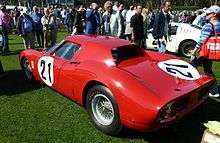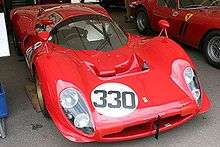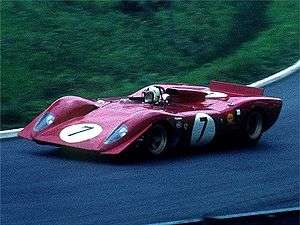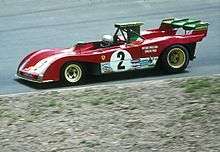Ferrari P
The Ferrari P series were sports prototype racing cars produced in the 1960s and early 1970s.
Although Enzo Ferrari resisted the move even with Cooper dominating F1, Ferrari began producing mid-engined racing cars in 1960 with the Ferrari Dino-V6-engine Formula Two 156, which would be turned into the Formula One-winner of 1961.
Sports car racers followed in 1963. Although these cars shared their numerical designations (based on engine displacement) with road models, they were almost entirely dissimilar. The first Ferrari mid-engine in a road car did not arrive until the 1967 Dino, and it was 1971 before a Ferrari 12-cylinder engine was placed behind a road-going driver in the 365 GT4 BB.
250 P

The 250 P was a Prototype racer produced in 1963, winning the 12 Hours of Sebring, 1000 km Nürburgring and the 24 Hours of Le Mans in that year. It was an open cockpit mid-engined design with a single-cam 3.0-litre 250 Testa Rossa V12 engine and was almost entirely unrelated to the other 250 cars.
275 P and 330 P
The 275 P and 330 P were evolutions of the 250 P with longer wheelbase and 3.3-litre or 4.0-litre engines, respectively. These cars raced during 1963 and 1964.
250 LM
The 250 P evolved into a saleable mid-engined racer for the public, the 250 Le Mans. Introduced at Paris in November, 1963, the LM was successful for privately entered racers around the world. Notably, a 250 LM entered by the North American Racing Team won the 1965 24 Hours of Le Mans driven by Jochen Rindt and Masten Gregory, which remains as Ferrari's last overall victory in the endurance classic. This car also is on display at the Indianapolis Motor Speedway Hall of Fame Museum. About 32 models were built in 1964 and 1965, with all but the first few powered by 3.3-litre 320 hp (238 kW) engines, though the name did not change with the increase in displacement. A fully independent double wishbone suspension was specified with rack and pinion steering and four wheel disc brakes. Ferrari had intended that the 250 LM be homologated for racing as a Group 3 Grand Touring Car, however in April 1964 the FIA refused to do so as Ferrari had built considerably fewer than the required 100 units. The 250 LM thus had to run as a Prototype until it was homologated as a Group 4 Sports Car for the 1966 season.[1]

The North American Racing Team Ferrari 250 LM that won the 1965 24 Hours of Le Mans is a popular attraction at classic car shows and was on display recently at the 2013 Amelia Island Concours d'Elegance.[2] A 1964 Ferrari 250 LM was auctioned off by Sotheby's in 2013 for a price of $14.3 million to an undisclosed telephone bidder. This bidding smashed the previous price record for this model.[3][4]
275 P2 and 330 P2

Two entirely new cars, the 275 P2 and 330 P2, followed in 1965. Featuring lower and lighter chassis and more aerodynamic body, the cars were paired with revamped versions of the previous 275 and 330 V12, now equipped with four camshafts and producing 350 hp and 410 hp, respectively. The 330 P2 was first used by Luigi Chinetti's North American Racing Team (NART) in the Daytona race that year. In 1965 275 P2 0836 won the 1000 km of Monza, 275 P2 0828 won the Targa Florio, 330 P2 0828 won the Nurburgring 1000 km, and 365 P2 0836or0838 won the 12 hr. Reims. The P2 cars were replaced by the P3 for 1966.
365 P2
For 1965 Ferrari also built a customer version of P2 cars; they were equipped with a SOHC 4.4 L engine and thus were named 365 P2. In 1966 Ferrari upgraded their 365 P2 cars with new bodywork by Piero Drogo.
330 P3
The 1966 330 P3 introduced fuel injection to the Ferrari stable. It also used a P3 (Type 593) transmission whose gears were prone to failure and were replaced by ZF transmission gears and other internals. The Ferrari 593 cases were retained because the distance from the mounting flange to the center of the output shaft on the ZF case is much longer than on the 593 case and won't allow a wheel to be centered in the P3 wheel arch. When P3 0844 and 0848 were first converted to 412 P's this 593 with ZF internals was fitted for one season after which the 593's with ZF internals were replaced by 603 (Not 603R as 412P 0854 603 gearbox stampings clearly show) transmissions in all the 412 P's.
Several Ferrari gearboxes are fitted with other manufacturer's gears and internals such as the 333 and the 430 GT2 which both have Hewland gears and other internals.
There are no longer any Ferrari P3s existent as the original P3 0846 was converted to a P4 and definitively written off and scrapped by Ferrari due to previous accident damage and fire damage it sustained at Le Mans 1967, and P3s 0844 and 0848 were converted to 412 P's by Ferrari. At a later point 412P 0844 was converted by Ferrari to a 330 Can-Am.
412 P

The Ferrari 412 P was a "customer version" of the famous 330 P3 race car, built for independent teams like NART (0844), Scuderia Filipinetti (0848), Francorchamps (0850), and Maranello Concessionaires (0854). These cars had carburetor engines instead of the factory Lucas fuel injection. Surviving 412 P cars are worth approximately $35–45 million USD according to Cavallino Magazines' current Buyers Guide.
There are only two cars that were originally built as 412 P's: 0850 and 0854. P3 chassis. P3 Typo Motors except for Carburetors in place of FI. P4 suspension 0844 and 0848 were originally P3 Factory Racecars but when Ferrari sold them to customers they removed the Lucas Mechanical Fuel Injection and replaced it with Weber carburetors which reduced their output, something Ferrari wanted to do so that they would win points but not beat the factory cars which were then P4 0846 (See Above), P4 0856, P4 0858, and P4 0860.
The P3's and 412 P had the same 4-liter block which is different from the P4-4 liter block and is 12mm longer than a P4 block and all had P3 not P4 chassis. All of the P3 chassis were made in 1966 at the same time but because of labor strikes only three of the five P3 chassis were built up into cars in 66. The unbuilt up P3 chassis were eventually build up into 412P 0850 and 0854 in 1967. P4 0846 was unique having, after modification by Ferrari for the 1967 race season, a P3 chassis with a P4 engine.
The 412 P and P4 models weren't eligible for the International Championship of Makes in 1968 as their engines were too large for the new 3 litre Group 6 Prototype category and too few examples had been built to allow homologation for the 5 litre Group 4 Sports Car category which required production of at least 50 units.[5] Ferrari did not contest the championship for a year in protest.
Four 412 Ps were built:
- 0844 was a converted by Ferrari from a P3 to a 412 P, then by Ferrari and NART to a 330 Can Am, and is currently in Germany fitted with a replica 412 P body.
- 0848 was a converted by Ferrari from a P3 to a 412 P and is currently in Switzerland.
- 0850 is an original 412 P and currently owned by an American.
- 0854 is an original 412 P and currently owned by James Glickenhaus, who also commissioned and owns the Ferrari P4/5.
P4
1967 was a banner year for the Enzo Ferrari motor company, as it saw the production of the mid-engined 330 P4,[6] a renowned V12 endurance car meant to replace the previous year's P3. Only four Ferrari P4-engined cars were ever made: three new 330 P4s and one ex P3 chassis (0846). Their three-valve cylinder head was modeled after those of Italian Grand Prix-winning Formula One cars. To this was added the same fuel injection system from the P3 for an output of up to 450 hp (335 kW).
The P3 won the 1000 km Monza in 1966, and the P4 won the same race in 1967. Two P4s, and one 412 P electrified the racing world when they crossed the finish line together (in first 0846, second 0856, and third place 0844) in the 1967 24 Hours of Daytona, for a photo finish to counter Ford's photo of the Ford GT40 Mk.II crossing the finish line together First, Second, and Third at the 1966 24 Hours of Le Mans.
Since then, the fate of these four nearly legendary cars has been the subject of much attention.
- 0846 no longer exists. Its number was cancelled by Ferrari after it was decided by the factory to discard the chassis to the Ferrari scrapyard due to its previous accident history and fire damage sustained at Le Mans, 1967.
- 0856 remains in its original state and is owned by Lawrence Stroll
- 0858 was converted into a 350 Can-Am by Ferrari[7] but is now fitted with a replica P4 Coupe body.
- 0860 was also converted by Ferrari to a 350 Can-Am but is presently wearing a replica P4 Spyder body and is in a French automobile museum
P4 Replicas

Due to the great fame and sleek appearance of the original design, more than a hundred P4 replicas of various design have been built. A high-quality P4 replica built with genuine Ferrari engine (e.g., a 400i V12) may command as much as $200,000, but simpler ones (often with Rover engines and Renault drive-trains) fetch around $50,000.
There have also been replica chassis built:
- 0003 is a replica built by David Piper using a chassis built by Silvano Cantelli in Modena and Mario Allegretti. The car currently has a Ferrari 312 F1 36 valve engine.
- 0900 was a continuation commissioned and currently owned by David Piper
- 0900a is another currently unfinished continuation also owned by Piper
- 0900b is a third continuation, but is still under construction. Its frame was made in the 2000s by Piper for an American customer.
312 P

After boycotting sports cars racing in 1968 to protest the rule change, Ferrari built another 3000cc prototype in 1969, named the 312 P.
The 3.0 Ferrari 312P Barchetta and 3.0 Ferrari 312P Berlinetta were hardly more than a 3-litre F1 Ferrari 312 with a prototype body. At the 12 Hours of Sebring the spyder finished 2nd to a JWA Gulf Ford GT40. At the BOAC 500 in Brands Hatch the same spyder was 4th behind three Porsche 908-01. At 1000km Monza, Chris Amon took the pole with the 312P spyder, ahead of Jo Siffert's 908-01, but had to retire. At the 1000km Spa, a 312P was second behind the Siffert-Redman 908-01LH. At Le Mans two 312P Berlinettas were entered. They were 5 and 6 on the grid, but didn't finish. At the end of the season the 312Ps were sold to N.A.R.T., the American Ferrari importer of Luigi Chinetti.
312 PB

In 1971, another rule change was announced for 1972, and Ferrari abandoned further development of the 512M in order to focus on a new 3 Litre prototype based on the 312B F1 car. The 312PB would prove fast but fragile in its debut at the 1971 Sebring 12 hours. Further development over the 1971 season brought increased reliability.
The 312PBs with the flat-12 boxer engine were very successful, winning ten out of eleven races in the 1972 World Championship for Makes and delivering the title to Ferrari. Scuderia Ferrari didn't enter the 1972 24 Hours of Le Mans, as Enzo Ferrari thought that the F1-based engine could not last the full 24 hours. He would be proven wrong.
The team competed in the 1973 24 Hours of Le Mans and finished second behind Matra, which would also be the teams' final standing in the 1973 championship. At the end of the 1973 season, Ferrari was forced by chief investor FIAT to abandon sports car racing, instead focusing on F1.
P4/5

In 2005, James Glickenhaus commissioned Pininfarina to rebody an Enzo as a special one-off custom car.[8] It is inspired by the early P racers. In May 2010 Glickenhaus announced that P 4/5 Competizione a new car based on P 4/5s designs but built to FIA GT2 Standards would be built and Raced at the 2011 24 Hours of Nurburgring by Scuderia Cameron Glickenhaus in an Experimental Class under the Direction of Paolo Garella Former Head of Special Projects at Pininfarina.
At The 2011 24 Hours of Nurburgring P 4/5 Competizione finished 2 in class and received a special Constructor's Trophy. After The 24 Hours of Nurburgring P 4/5 Competizione was displayed in The National Auto Museum of Italy in Torino for a month.
For the 2012 Racing season P 4/5 Competizione was modified and KERS was added. At The 2012 24 Hours of Nurburgring P 4/5 Competizione M finished 1 in Class, 12 OA and Won The FIA Alternate Energy Cup. It is the highest finishing Hybrid GT car to ever finish a major 24 Hour Endurance Race.
References
- ↑ Twite, Michael L (1971). The World's Racing Cars, Fourth Edition. Macdonald. p. 114. ISBN 0356031551.
- ↑ "The Last Ferrari To Win The 24 Hours of Le Mans - The 1965 Ferrari 250 LM At Amelia Island". mycarquest.com.
- ↑ Katya Kazakina (22 November 2013). "Ferrari 250 LM Sells for Record $14.3 Million in New York". Bloomberg.
- ↑ "1964 Ferrari 250 LM by Carrozzeria Scaglietti". RM Auctions.
- ↑ M.L. Twite, The World's Racing Cars, Fourth Edition, 1971, page 109
- ↑ "Ferrari 330/P4". Road & Track (May 1967): 114–116.
- ↑ Bissett, Mark. "Ferrari P4/CanAm 350 "0858"". primotipo.com. Retrieved 30 April 2016.
- ↑ "The Beast of Turin". Car and Driver (September 2006): 86–93.
External links
| Wikimedia Commons has media related to Ferrari P. |
- Ferrari pages: 250 P, 330 P, 250 LM, 275 P, 275 P2, 330 P2, 365 P, 330 P3, 330 P4, 412 P, 312 P, 512 S, 512 M, 312 P (1971), 512 BB LM